Banaban Traditional Weddings
Past and Present: An important cultural ceremony proudly passed down over the generations
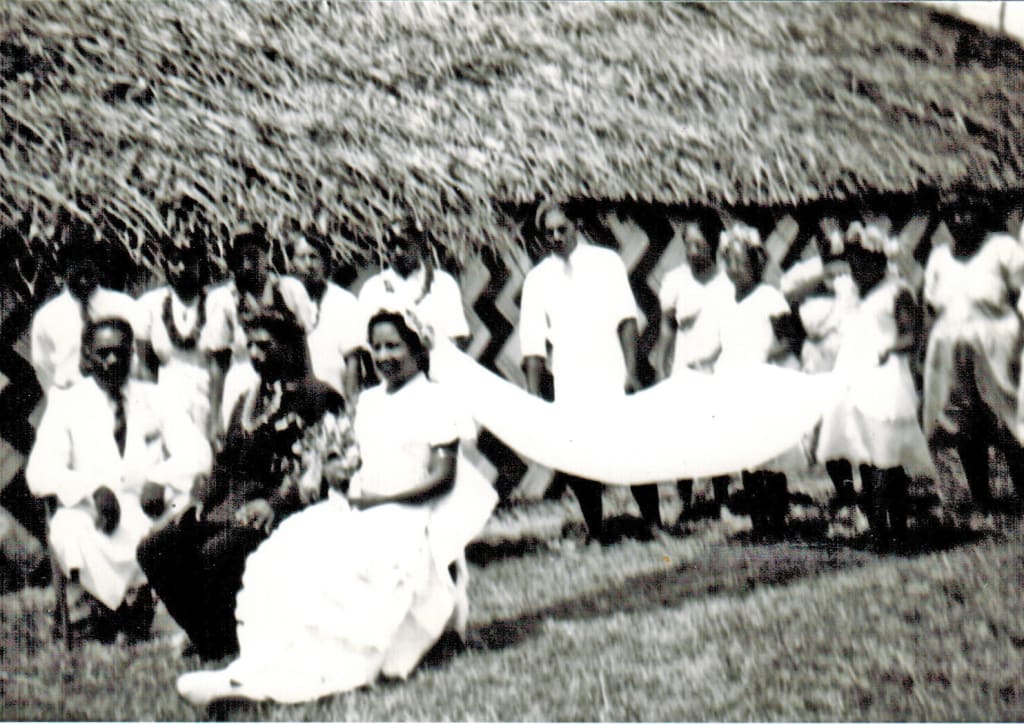
Excerpt: Chapter 18: Customs and Culture, Te Rii ni Banaba, backbone of Banaba, Raobeia Ken Sigrah and Stacey M King (2001; 2019).
BANABAN CUSTOMS AND CULTURE
Engagement and Marriage
Marriages were arranged to link families and gain land or crucial rights. Today, although issues of land and rights are less important, the linking of two families is still valued. Thus, as soon as a child was able to talk and walk, from approximately five years of age, he or she could be betrothed to marry. As the children grew older and began to understand life, they were encouraged to play with their chosen partner. When the girl’s first period occurred, her parents and elders set a wedding date. By about ten years of age, both children knew that their playmate would become their spouse. Marriages were conducted at an early age to ensure that girls were virgins when they were married, and this is still part of custom today. Marriage does not mean that the couple leads an independent life; on the contrary, family bonds are even stronger. So, if any problems arise between the couple, the whole family is involved in resolving the issue quickly, and the elders of the family will step in if required to settle the matter.
Engagement customs
After the arrival of Nei Anginimaeao on Banaba, people began to practice te kakoaki (bleaching process). In this process, the engaged girl or boy spent two to three months in a heavily screened house, away from the scorching rays of the sun. They were fed a special diet and permitted to go outside only at night. As a result, they were well prepared physically for their upcoming marriage, and their skin would lighten considerably. By the time of the wedding, the bride and groom stood out with fair skin and trim figures. Although the ceremony of te kakoaki had disappeared by the 1800s, the evidence suggests that some engagement customs were practised for several weeks in the lead-up to the wedding. When not working, the young couple wore a new riri (grass skirt), flowers in their ears, and flower garlands around their necks. They made chaperoned visits to their respective relatives, and the two families exchanged presents of coconuts and mats.
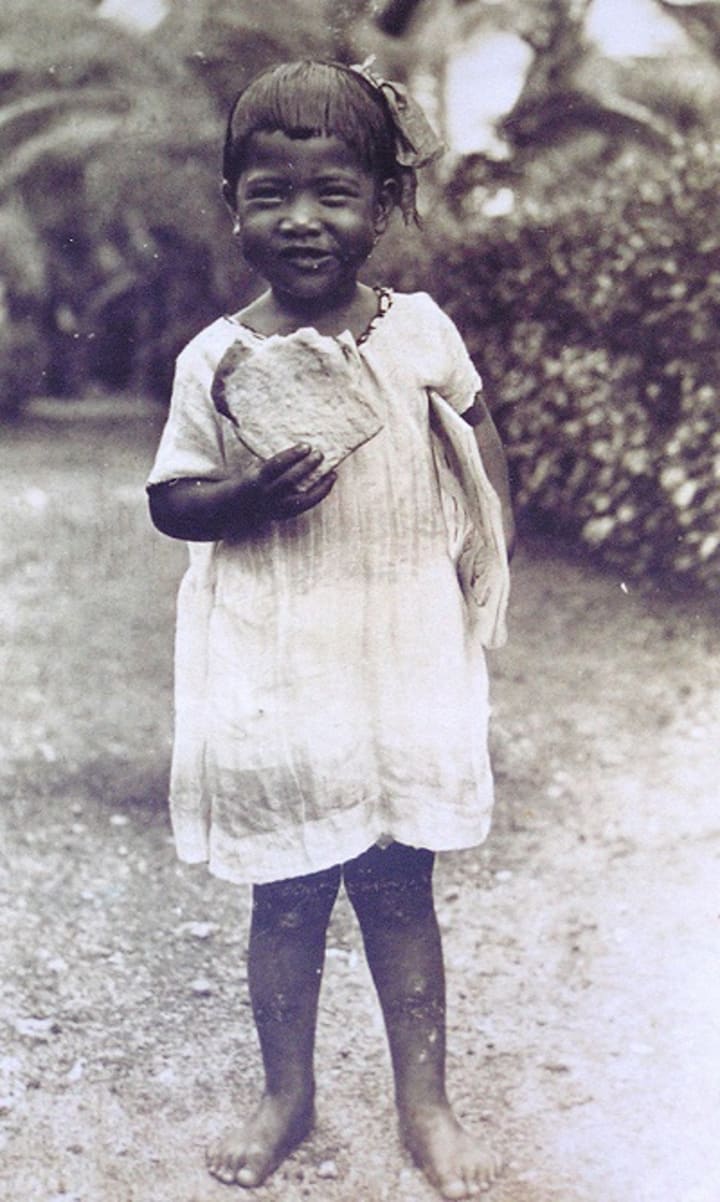
Wedding Ceremony
Thanks to Webster’s visit to Banaba in 1851, we have a written account of a traditional Banaban wedding ceremony as it was before the arrival of the missionaries:
“No man in Panapa [Banaba] has more than one wife. When a young man is paying his addresses to a girl, he affixed a band of leaves around his ankle. The children are frequently betrothed as husband and wife when very young. On arriving at a certain age, they are united by a formal marriage ceremony. The age at which these nuptials take place is generally that of fourteen. The young people sleep together several nights before the marriage. The nuptials are consummated by extensive feasting, and a meeting of friends and relatives, as well as other ceremonies at which the old women officiate”.
In the ceremony of old, the actual ritual or marriage ceremony itself would go on for days. When Webster says that the young couple slept together a few days before the actual marriage, what he is referring to are the arrangements for the couple who, being so young and virgins, do not know what is required to consummate their marriage physically. Here the old women within the families provide help, through what he refers to as certain rites. This assistance can still be called on today when a young couple needs to prove the bride’s virginity to their families and relatives.
The question of the boy’s virginity is less critical, but if he is a virgin and does not know what to do, the old women will be called upon to assist them on the wedding night. Once this part of the ceremony is over, the families of the couple are anointed with oil. The groom’s relations will anoint the bride’s relations with special scented oil as a symbol of their daughter’s virginity. The whole wedding party then rejoices, and the celebrations move into full swing again, for a week or two of constant feasting and dancing, and the coming together of the two families and all their relatives. The elders from both sides decide when the celebrations are over.
Today on Rabi, red cloth is used by the utu (immediate family) to symbolise the bride’s virginity. After the wedding night, relatives wear red coloured te be (sarongs) and fly red flags and banners in celebration of the event. Weddings today still incorporate traditional customs and rituals, and weddings are regarded as one of the most important cultural events within society. The ceremony is similar to the one Webster described, reduced to one day, although celebrations can continue for one or two weeks.
__________________
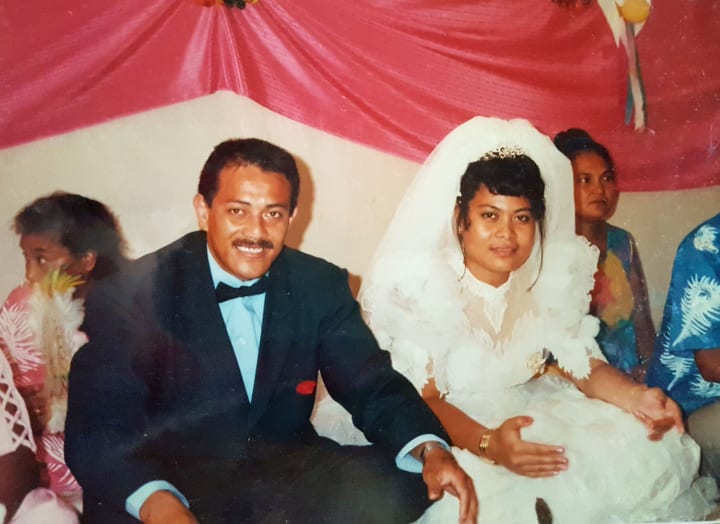
The following two winning stories [1] were written by young Banaban high school students and relate to Banaban Traditional Weddings practised by Banabans on Rabi, Island since their arrival on the island in December 1945.
BANABAN TRADITIONAL WEDDINGS
Written by Toatara Raturo, 1st Prize Winner, Banaban Literary Prize
Engagement
The arrangements for the engagement is very complex.
First of all, the boys family write a letter requesting the hand of the girl concerned. When the girl’s parents receive the letter, they call their relatives to come together. This is because the whole family unit as a whole will decide whether the boy is accepted or not. When the decision is then made, the girls family then reply to the boys family.
If the request is approved, then the boys family would gather, and with the ring and the gift of clothes for the particular girl and then they visit the te kaaba (shed) that has already been made and by the girls’ parents in preparation for their visit.
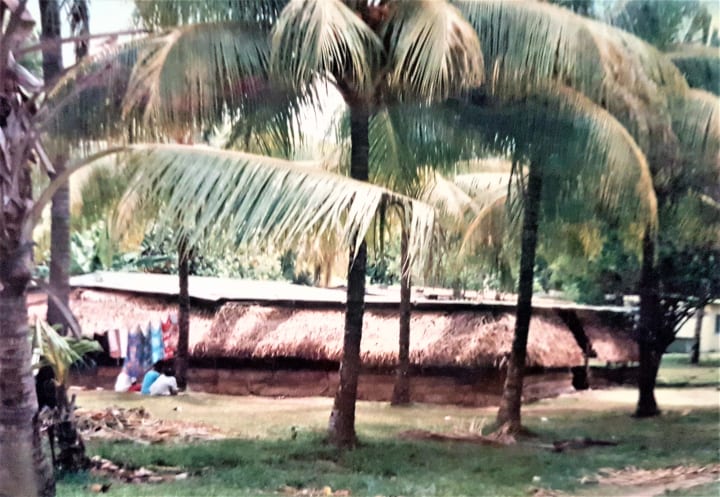
In te kaaba, the boys taian ne kautabo (relatives) are regarded as very special people and should do whatever the girls’ relatives ask and request. If not, the ring is returned back to them. By doing whatever the girls’ family requests, the kautabo, shows the love their bue (son) has for the girl.
After all the arrangements are made, then there is a dance inside the te kaaba showing great joy from the boy’s family towards their daughter or granddaughter. Straight after this, the relatives would return to their homes waiting for the day of the marriage.
Preparation for the Wedding
A big preparation is made by both families and their relatives. The family’s concern is knowing that nobody else can prepare the event for them, so they give different tasks to individual family members.
The young man’s family are given tasks. Including planting a required amount of dalo or cassava. Another is tasked with breeding the required number of pigs or cattle and many other tasks.
The young woman’s family are also required to make a certain number of mats, sew the customary costumes for the bride and groom. All these tasks need to be completed in time for the wedding day.
The young betrothed couple also undertake preparations. The girl learns the art of making cultural decorations, cooking, etc. She also much keep herself away from her peer group so that she retains good moral characteristics.
The young man is also required to maintain good morals. He is expected to prepare a garden of his own, if not already owning one, and he has to learn the skills to survive on his own and become an adult. How to fish, how to cut and make coconut toddy, and many other skills.
All these preparations are done before the wedding so that when the time comes to separate from their parents there will be no problem for them to survive on their own.
If both families have prepared the couple well, that there will be no problems with the preparations for the wedding moving forward. The more preparation the young couple undertake, the more the relatives will spend and contribute towards the wedding feast.

One or two weeks, or sometimes even one month prior to the wedding the close relatives will begin to attend to the family. They will begin to build a large te kaaba first because that is the main place for the ceremony to be conducted. Next, they will build ovens for baking and then spear toilets which the newlywed couple will use. Lastly, they will make and decorate the pathway from the main entrance to the te kaaba which is called te bwerei.
While all these are being done, the young men and boys will prepare the firewood, so that there will be no shortage during the event. Men will go looking for workers to help them, while women will bake and provide food for the workers. As the wedding approaches everybody will be busy attending to their work in and outside the house and kitchen.
When it is time for the wedding, the bride and the bridegroom are prepared and dressed in their customary suits. They will then go to the village church where the priest or minister will officially marry them. After the couple is married, the feast will begin.
In the night, the girl will be with the boys family where she is to sleep with her new husband. The Banabans view this aspect of the ceremony as very special. This is the time that the husband will find out if his new wife is a virgin or not. If she is found not to be a virgin then the decision would be up to the husband whether he loves her or not. If the husband does not accept her, the girl will be sent back to her parents where her fate will be decided because this outcome brings shame upon her family.
If the girl is found to be a virgin then there will be a great celebration. There will be dancing, singing and laughing. The boys family will then gather a few family members to go to the girl’s side to oil, te kabiribiri, the people. This practice is a customary or traditional practice, telling the girls family that their daughter or granddaughter is a girl of good character and she has been raised well by her family.
The celebration for both families will continue for about a week to rejoice and show their love for the young couple and their new life together.
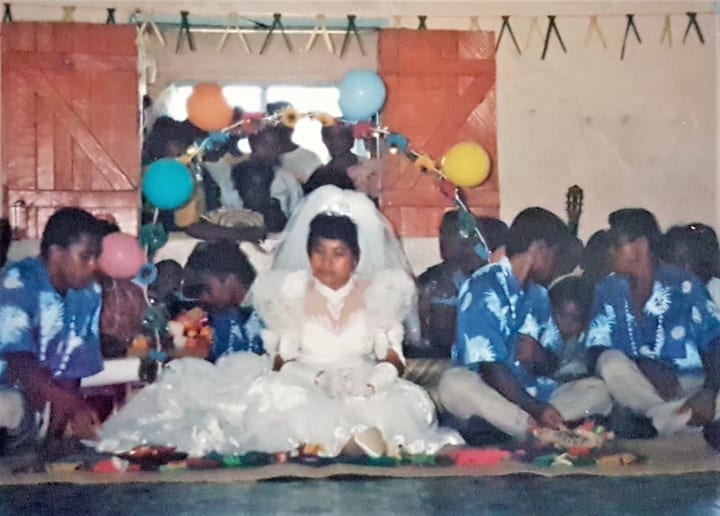
After the Wedding
When the wedding is over, both families will then decide when to finally disperse. Usually, the close relative will stay back for a longer period of time while the other family guest will return back to their homes as soon as the feast is over.
The family that is left behind will celebrate until they think they have had enough. While all these events are taking place the cooking and baking continue to provide for the festive activities.
The remaining family will finally gather to discuss the breaking up of te kaaba and how to pay the remaining debts to the local shops. All this is being discussed as a close family unit. When these issues are settled and discussed that the wedding is finally complete. Only the new married couple and their immediate family remain.
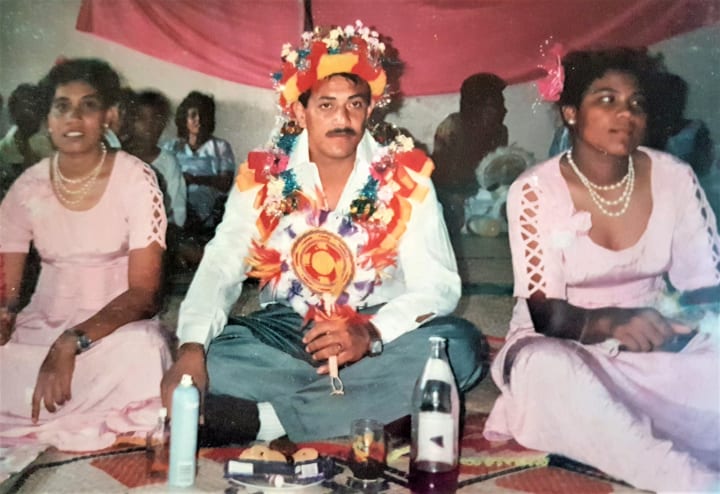
Advantages of Banaban Weddings
Although there are many disadvantages, there are also many advantages of a customary Banaban wedding.
Firstly, with the help of older Banabans, the younger ones are learning to treasure the traditional ways and customs of the wedding practice that has been passed down over the decades. Most young Banabans learn from the experience of attending a traditional wedding. Young girls also learn what they should do and not do when they are married from an early age and from observation. They also lean the special customs carried out under the te kaaba. They learn the process of what they should do when the girls family goes over to the boy’s side of the family and in return, how to react when the boys family comes over to their side of the family. They learn the importance of oiling the new relatives. The boys also learn what is expected of them at this important cultural event.
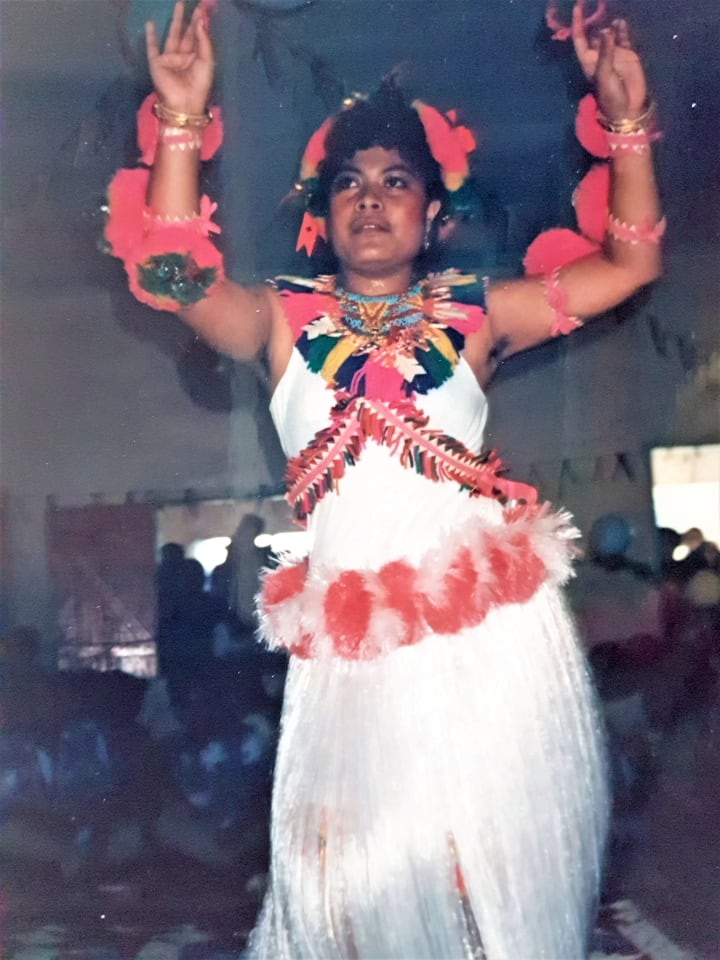
Secondly, the families involved get to meet and formally recognise their new relatives. They will begin to learn the status and relationship of the other relations. Young boys and girls on both sides of the families get to know each other.
Furthermore, the wedding provides great rejoicing as a whole. Maybe some of the people who do not know how to dance will learn from joining in during the event. At a Banaba wedding, there is no age limit in the dance. There is great happiness and maybe those who maybe be grieving will be lightened during the gathering. Generally, Banaban weddings result in ninety-nine percent rejoicing with the rest taken up in hard work.
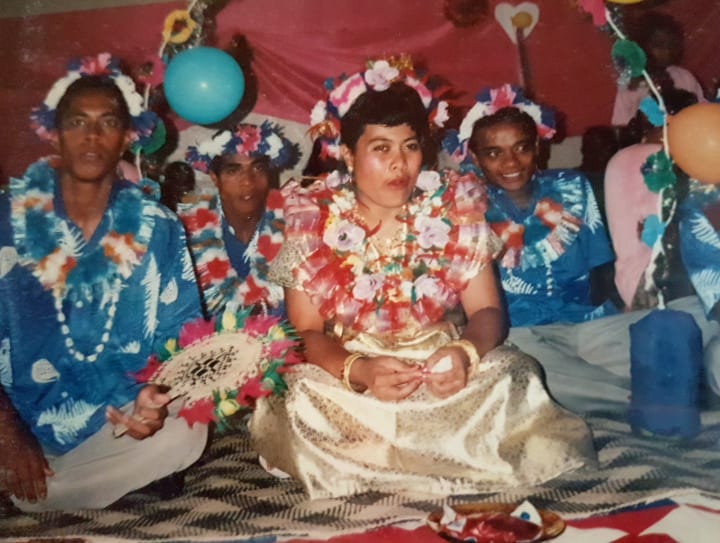
Disadvantages of Banaban Weddings
But there are also disadvantages to a traditional or customary wedding ceremony.
One of the disadvantages is the dancing which is usually done to show happiness. This dancing custom is well known to young boys and some tend to make homebrew out of coconut toddy in readiness for the dance. These young boys will then drink and when intoxicated enter the te kaaba during the dance ceremony, ignoring the necessary protocols. This causes shame and usually leads to trouble arising.
Another disadvantage is the time in which the wedding consumes. The long the wedding, there is an increase in debts. The debts then accumulate because of the additional food needed with people having to source more food from the island traders or local foods stores.
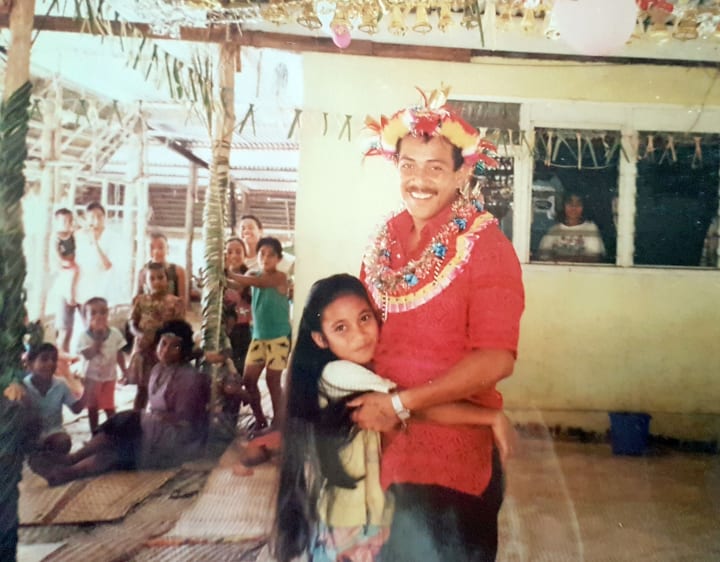
Due to the large debts that can accumulate from such a large event, the family has to live very poorly, sometimes for months in order to repay the debts.
Furthermore, the young and old men will not attend to their own housework because of continuing celebrations and the consumption of grog (kava or toddy) at the event. Many of the men will laze around feeling hungover and give the women a hard time by not doing the much-needed household chores of providing cassava or cutting firewood for their families.
______________________
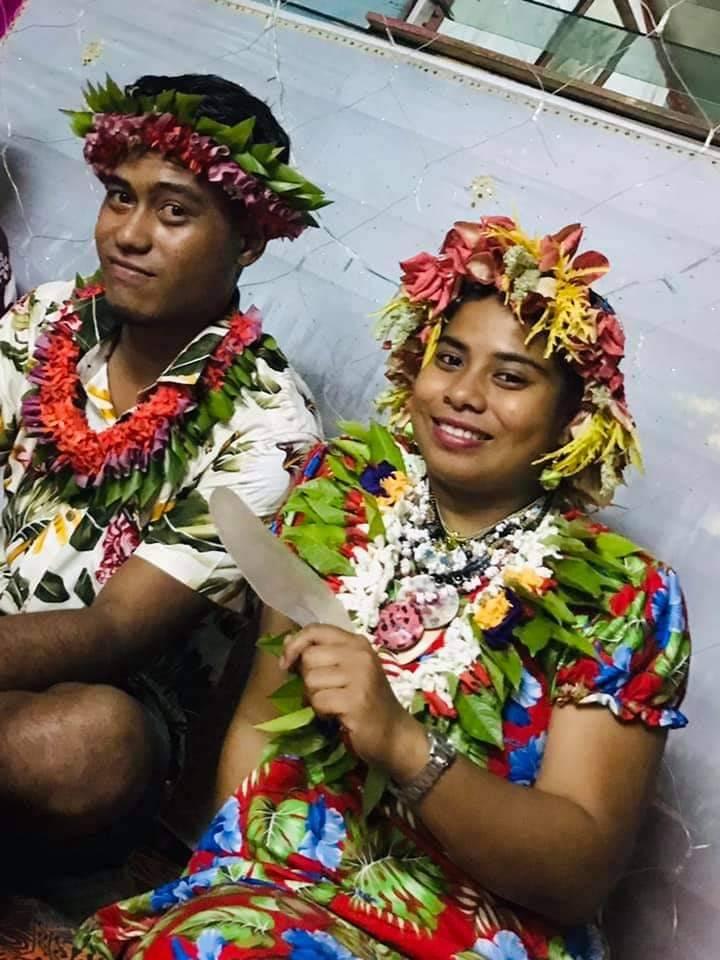
A BANABAN WEDDING ON RABI ISLAND
By Rutu Rotan, 2nd Prize Winner 1996, Form 6M, Rabi High School, Rabi, Fiji
Introduction
A Banaban wedding is expensive. This is because virginity is highly regarded amongst the Banabans. If a girl marries and she is a virgin then there will be a big celebration but if she is not a virgin there will be no celebration and her parents will be embarrassed and try to get their daughter back.
Wedding Proposal
During the proposal, the proposal the boy’s parents gather their family and decide to write to the girl saying that they think she is a good match for their son.
When the girl’s parents receive the letter, they gather the family and discuss the matter while the boy’s family wait in anticipation of the reply.
If the girls’ family think that the boy is a good match for their daughter then they will reply. If they think the boy is not a good match, they will not reply.
If the boy’s proposal is accepted, the boy’s parents will come to the girl’s house with their ring. In the past, before they entered the house, the girl’s aunt or grandmother would wash their feet with water and dry their feet with their long hair. This part of the ceremony is not practised today.
The families will then decide the time for the wedding.
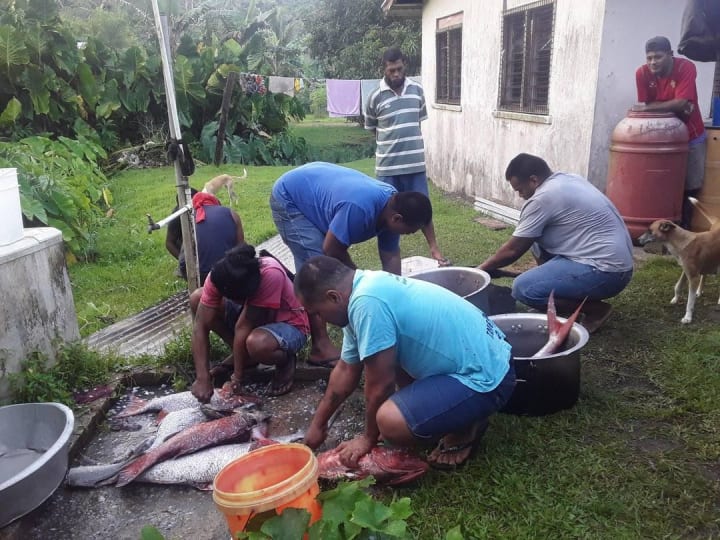
Pre Wedding Activities
One of two months before the wedding, the two sides of the family gather at their various places and have to cater and pay the expenses.
A special house is built for the family to sleep in. A traditional bathroom is built where the bride and groom will bathe in. The house is painted, the compound cleaned and expensive shopping is done. The boy’s parents have to buy the girls clothes and other things that are required for the wedding.
A day before the wedding, the bride to be is brought to her inlaws, while the groom to be is taken to his future inlaws. Today this protocol seldom happens but if it does, it is because both families have the pleasure and joy of dressing their future daughter inlaw in her wedding costume.
On the Wedding Day
The couple wears traditional western-style wedding clothing. A white gown and veil for the bride and a suit for the groom. The wedding ceremony is conducted in the church in the morning and usually ends around lunchtime. This is followed by feasting which is held in the village or community hall.
After the feast, dance follows. Again modern equipment is used with a local band. In between the music, traditional songs and dances take place.
Each family occupies either end of the hall. The other family members face them on either side of the hall. The new bride sits in front of her new inlaws and the groom does likewise. Every half hour or so, the newly married couple will change into new clothes as provided by their inlaws.
The entertainment ends in the evening and the new couple is taken to the groom’s house for the evening.
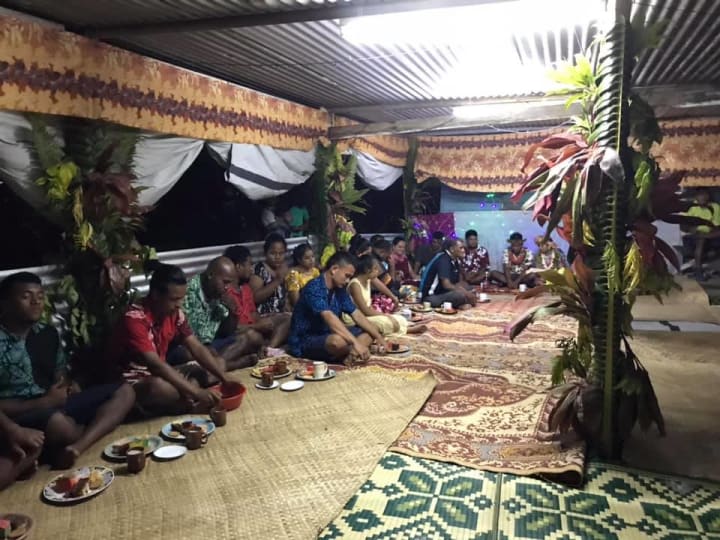
Suspense on the Wedding Night
The first night of the wedding is very important and is the highlight of the wedding day. This is when the public knows if the bride is a virgin or not.
After the couple has had sexual intercourse, the groom will leave the bedroom. His aunt or grandmother will enter the bedroom to check whether there is blood stains on the bedsheets. This is evidence that the bride is a virgin and the fact is announced with joy to those staying in the house. The news is received with dancing and there is a pouring of special scented oil amongst the household members.
A group is then selected to take the news to the bride’s relatives. They would travel at the same time and upon arrival at the bride’s place, they would pour oil on everybody they come across.
If the bride is not a virgin, there is no celebration and no pouring of oil. If the bride’s relatives realise after some time that no one is coming to pour oil, they will try and get their daughter back. This is often unsuccessful because the groom assures them that he loves their daughter.
Conclusion
Though this wedding is very expensive and may appear absurd in the modern age, it has been a feature and unique aspect of the Banaban Culture which has been passed down from generation to generation. It is a cultural practice that Banabans are very proud of.
Sexually transmitted diseases are unheard of on Rabi Island. In fact, according to reliable sources from Rabi hospital, a case of STD has never been reported (1996) or treated. The main reason is because of this important aspect, I as a Banaban feel proud of my culture.
__________________
1. Banaban Literary Prize, 1994-96, Te Karaki Nikawai (Stories of the Past). An annual event encouraged students from Rabi High School, Fiji to talk with their Elders and submit entries based on Banaban Cultural practices.
Get the Book!
Read more about Traditional Banaban weddings and the epic history of Banaba (Ocean Island) and the Banaban people (The Forgotten People of the Pacific) as they try and seek justice to save their island, their culture, their future, "Te Rii ni Banaba- backbone of Banaba" by Raobeia Ken Sigrah and Stacey M King, available on Amazon here.
About the Creator
Stacey King
Stacey King, a published Australian author and historian. Her writing focuses on her mission to build global awareness of the plight of the indigenous Banaban people and her achievements as a businesswoman, entrepreneur and philanthropist.






Comments
There are no comments for this story
Be the first to respond and start the conversation.